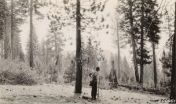(Press-News.org) Large wind farms are being built around the world as a cleaner way to generate electricity, but operators are still searching for the most efficient way to arrange the massive turbines that turn moving air into power.
To help steer wind farm owners in the right direction, Charles Meneveau, a Johns Hopkins fluid mechanics and turbulence expert, working with a colleague in Belgium, has devised a new formula through which the optimal spacing for a large array of turbines can be obtained.
"I believe our results are quite robust," said Meneveau, who is the Louis Sardella Professor of Mechanical Engineering in the university's Whiting School of Engineering. "They indicate that large wind farm operators are going to have to space their turbines farther apart."
The newest wind farms, which can be located on land or offshore, typically use turbines with rotor diameters of about 300 feet. Currently, turbines on these large wind farms are spaced about seven rotor diameters apart. The new spacing model developed by Meneveau and Johan Meyers, an assistant professor at Katholieke Universiteit Leuven in Belgium, suggests that placing the wind turbines 15 rotor diameters apart -- more than twice as far apart as in the current layouts -- results in more cost-efficient power generation.
Meneveau presented the study results recently at a meeting of the American Physical Society Division of Fluid Dynamics. Meyers, co-author of the study, was unable to attend.
The research is important because large wind farms – consisting of hundreds or even thousands of turbines – are planned or already operating in the western United States, Europe and China. "The early experience is that they are producing less power than expected," Meneveau said. "Some of these projects are underperforming."
Earlier computational models for large wind farm layouts were based on simply adding up what happens in the wakes of single wind turbines, Meneveau said. The new spacing model, he said, takes into account interaction of arrays of turbines with the entire atmospheric wind flow.
Meneveau and Meyers argue that the energy generated in a large wind farm has less to do with horizontal winds and is more dependent on the strong winds that the turbulence created by the tall turbines pulls down from higher up in the atmosphere. Using insights gleaned from high-performance computer simulations as well as from wind tunnel experiments, they determined that in the correct spacing, the turbines alter the landscape in a way that creates turbulence, which stirs the air and helps draw more powerful kinetic energy from higher altitudes.
The experiments were conducted in the Johns Hopkins wind tunnel, which uses a large fan to generate a stream of air. Before it enters the testing area, the air passes through an "active grid," a curtain of perforated plates that rotate randomly and create turbulence so that the air moving through the tunnel more closely resembles real-life wind conditions.
Air currents in the tunnel pass through a series of small three-bladed model wind turbines mounted atop posts, mimicking an array of full-size wind turbines. Data concerning the interaction of the air currents and the model turbines is collected by using a measurement procedure called stereo particle-image-velocimetry, which requires a pair of high-resolution digital cameras, smoke and laser pulses.
Further research is needed, Meneveau said, to learn how varying temperatures can affect the generation of power on large wind farms. The Johns Hopkins professor has applied for continued funding to conduct such studies.
INFORMATION:
Related links:
Johns Hopkins video on wind turbine research:
http://www.youtube.com/watch?v=U3F9qGo549k
Johns Hopkins News Release - Wind Turbines Produce 'Green' Energy — and Airflow
Mysteries: http://www.jhu.edu/news/home07/dec07/wind.html
National Science Foundation Feature - Lab Tests Show Wind Turbine's Air Flow:
http://www.nsf.gov/discoveries/disc_summ.jsp?org=NSF&cntn_id=112626&preview=false
Charles Meneveau's research page: http://www.me.jhu.edu/meneveau/
Johns Hopkins Department of Mechanical Engineering: http://www.me.jhu.edu/
Study yields better turbine spacing for large wind farms
2011-01-21
ELSE PRESS RELEASES FROM THIS DATE:
Are positive emotions good for your health in old age?
2011-01-21
The notion that feeling good may be good for your health is not new, but is it really true? A new article published in Current Directions in Psychological Science, a journal of the Association for Psychological Science, reviews the existing research on how positive emotions can influence health outcomes in later adulthood.
"We all age. It is how we age, however, that determines the quality of our lives," said Anthony Ong of Cornell University, author of the review article. The data he reviews suggest that positive emotions may be a powerful antidote to stress, pain, ...
With chemical modification, stable RNA nanoparticles go 3-D
2011-01-21
CINCINNATI—For years, RNA has seemed an elusive tool in nanotechnology research—easily manipulated into a variety of structures, yet susceptible to quick destruction when confronted with a commonly found enzyme.
"The enzyme RNase cuts RNA randomly into small pieces, very efficiently and within minutes," explains Peixuan Guo, PhD, Dane and Mary Louise Miller Endowed Chair and professor of biomedical engineering at the University of Cincinnati (UC). "Moreover, RNase is present everywhere, making the preparation of RNA in a lab extremely difficult."
But by replacing a ...
Louisiana Tech University professor visits India as part of US delegation on energy issues
2011-01-21
RUSTON, La. – While most people were busy shopping during the holiday season, Dr. Daniela Mainardi, associate professor of chemical engineering at Louisiana Tech University and member of the Institute for Micromanufacturing, was preparing for a trip that would take her half way around the world.
As part of a joint effort, Mainardi, together with Virendra Mathur from the University of New Hampshire, and Suddhasatwa Basu and Shantanu Roy from The Indian Institute of Technology-Delhi, was in charge of organizing a workshop titled, "Energy and Environment: Challenges and ...
Latest American Chemical Society podcast: Biodegradable foam from milk protein and clay
2011-01-21
WASHINGTON, Jan. 20, 2011 — The latest episode in the American Chemical Society's (ACS) award-winning podcast series, "Global Challenges/Chemistry Solutions," focuses on development of a new ultra-light biodegradable foam plastic material made from two unlikely ingredients: The protein in milk and ordinary clay.
The material could be used in numerous products, researchers report in the ACS' Biomacromolecules, a monthly journal. The finding comes amid ongoing concern about plastic waste accumulating in municipal landfills, and reliance on imported oil to make plastics.
David ...
Scripps Research scientists find measles' natural nemesis
2011-01-21
LA JOLLA, CA – January 20, 2011 – Scientists at The Scripps Research Institute have found that a known enzyme in cells protects against measles virus, likely by altering the virus's genetic material, RNA. Cells lacking the enzyme become highly vulnerable to the virus's destructive effects. The enzyme also protects against several other respiratory viruses, including influenza A.
"We believe that host cells use this RNA-editing enzyme to slow these viruses' ability to replicate," said Michael B. A. Oldstone, the study's senior author and a professor at Scripps Research's ...
War, plague no match for deforestation in driving CO2 buildup
2011-01-21
Stanford, CA— Genghis Khan and his Mongol hordes had an impact on the global carbon cycle as big as today's annual demand for gasoline. The Black Death, on the other hand, came and went too quickly for it to cause much of a blip in the global carbon budget. Dwarfing both of these events, however, has been the historical trend towards increasing deforestation, which over centuries has released vast amounts of carbon dioxide into the atmosphere, as crop and pasture lands expanded to feed growing human populations. Even Genghis Kahn couldn't stop it for long.
"It's a common ...
Insect eyes inspire improved solar cells
2011-01-21
WASHINGTON, Jan. 20 – The eyes of moths, which allow them to see well at night, are also covered with a water-repellent, antireflective coating that makes their eyes among the least reflective surfaces in nature and helps them hide from predators in the dark. Mimicking the moth eye's microstructure, a team of researchers in Japan has created a new film, suitable for mass-production, for covering solar cells that can cut down on the amount of reflected light and help capture more power from the sun.
In a paper appearing in Energy Express (www.OpticsInfoBase.org/ee), a ...
For robust robots, let them be babies first
2011-01-21
VIDEO:
A two-minute video, "Morphological Change in Machines Accelerates the Evolution of Robust Behavior, " was produced by the Morphology, Evolution and Cognition Laboratory, University of Vermont, 2011.
Click here for more information.
Want to build a really tough robot? Forget about Terminator. Instead, watch a tadpole turn into a frog.
Or at least that's not too far off from what University of Vermont roboticist Josh Bongard has discovered, as he reports ...
Gene test shows which bladder cancer patients may have cancer spread
2011-01-21
AURORA, Colo. (Jan. 20, 2011)--Cancer scientists have designed the first molecular test to predict which bladder cancer patients may have cancer involvement in their lymph nodes at the time of surgery—which could help doctors determine which patients are good candidates for pre-surgical, or neo-adjuvant, chemotherapy.
The test analyzes 20 genes on tumor biopsies, according to a paper published online Jan. 20, 2011, in Lancet Oncology.
"Randomized clinical trials have shown that giving neo-adjuvant chemotherapy extends patient lives, but only 5 to 15 percent of patients ...
UC Davis study shows plants moved downhill, not up, in warming world
2011-01-21
In a paper published today in the journal Science, a University of California, Davis, researcher and his co-authors challenge a widely held assumption that plants will move uphill in response to warmer temperatures.
Between 1930 and 2000, instead of colonizing higher elevations to maintain a constant temperature, many California plant species instead moved downhill an average of 260 feet, said Jonathan Greenberg, an assistant project scientist at the UC Davis Center for Spatial Technologies and Remote Sensing.
"While the climate warmed significantly in this period, ...


